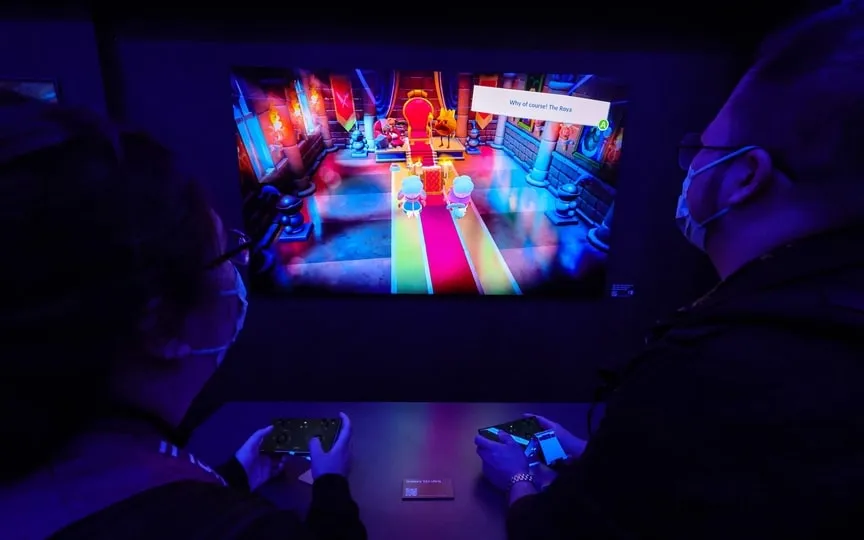Video games at CES 2024 dominated by immersive, 3D, and ultra-fast displays
The Consumer Electronics Show (CES) has long been the stage for unveiling groundbreaking gaming innovations, and the trend continued in 2024. Major players in the industry, including Xbox, PlayStation, and Samsung, made significant announcements at the conference held in Las Vegas, Nevada, from January 9th to 12th.
From ergonomic controllers of the future, to comfortable headrests for gaming chairs and powerful new graphics cards, there was no shortage of cool new technology on display for the gaming community at CES.
However, after the dust settled in the Las Vegas desert, perhaps the most notable gaming theme from CES was displays.
Over the years, the development of virtual reality (VR) and graphics cards have moved the gaming experience closer and closer to “photorealism”, which means that video games come closer to the experience of life in the real world.
But VR doesn’t change that immersive experience. Increasingly, larger screens, curved screens and panels that can be viewed horizontally or vertically have taken the gaming experience to the next level.
These next-generation monitors were on display at CES 2024 and excited gamers around the world.
3D experience without glasses
The Acer Predator SpatialLabs View 27, a modification of Acer’s existing SpatialLabs monitors, is aimed at gamers and offers a glass-free 3D display.
The display uses Acer’s SpatialLabs software to render full 3D games without 3D glasses, using a special lens-like lens layer and integrated eye-tracking cameras that work even when you nakedly tilt and move your head during gameplay.
The 4K display creates separate images for each eye, resulting in 2K resolution per eye in 3D mode with a refresh rate of up to 160 Hz.
Samsung also presented an interesting alternative at CES. Its 37-inch 2D/3D game screen, which, as the name suggests, can be used in either two or three dimensions depending on the users’ needs. The display was awarded the Best of Innovation award in the Gaming and eSports category at CES – highlighting its versatility to help users with everything from gaming to productivity.
The screen counts down for a high-resolution 2D experience, but when it’s time to game, the screen can display 3D images in 4K quality, taking immersion to a new level. The display itself can control the intensity and direction of the graphics, thanks to artificial intelligence (AI) vision recognition technology and other advances that promise to bring the VR experience to a flat screen.
The speed reaches OLED screens
It seems that display manufacturers are now in a fierce “megahertz” battle. Liquid crystal displays (LCDs) have reached a refresh rate of around 500 Hz, while organic light emitting diodes (OLEDs) are the next evolution between visual quality and speed.
Many manufacturers are working hard to increase the refresh rates of their OLED-to-show displays.
Samsung, Dell and MSI introduced 27-inch screens with 1440p resolution at 360 Hz. Asus won all three with a 27-inch 480Hz display. Likewise, LG and Asus introduced 32-inch “Dual-Hz” monitors with an impressive 4K-240Hz setting – which can be boosted to 480Hz, but only at a lower resolution.
Smaller players show up on game screens
The traditional technology giants did not present their powerful displays. Smaller companies that seem born to make gaming more immersive are also flexing their muscles at CES.
You might not know Brelyon now, but they sure caught the eyes of gamers. The Silicon Valley-based deeptech startup creates desktop displays for gamers, including the massive Brelyon Ultra Reality. The display is described as the first desktop monitor to offer image depth, allowing for a massive field of view and screen size that means a more immersive gaming experience.
Its technology also promises to relax the eye muscles, reducing eye strain. This is thanks to hours of simulations that allowed engineers to optimize the 3D profile of the depth plane to create the best balance between immersion and comfort.
Many of the most common technologies used by large companies in their gaming departments today started as startups at some point. In Brelyon’s case, they have received several venture funding rounds from venture capital firms, including One Way Ventures, which backs immigrant founders in the United States.
As the video game industry evolves, both startups and large tech companies are bringing us closer to a more immersive gaming experience.




